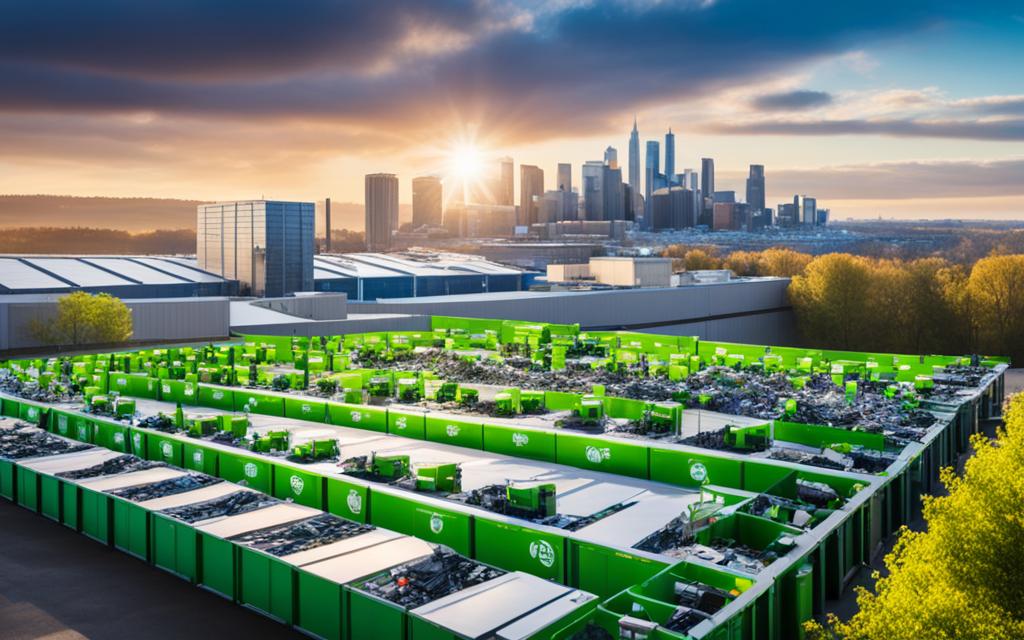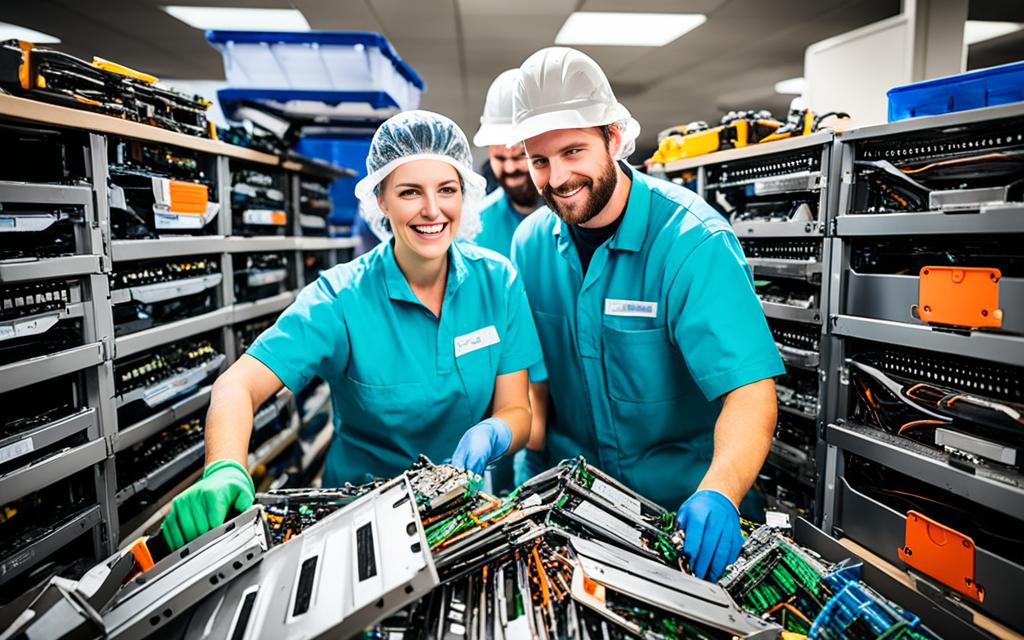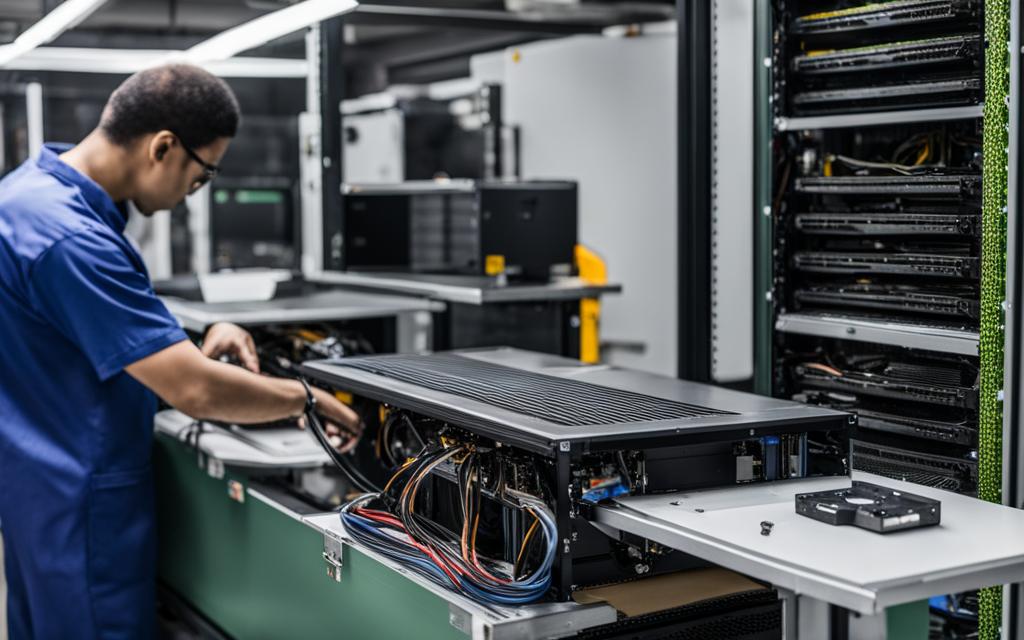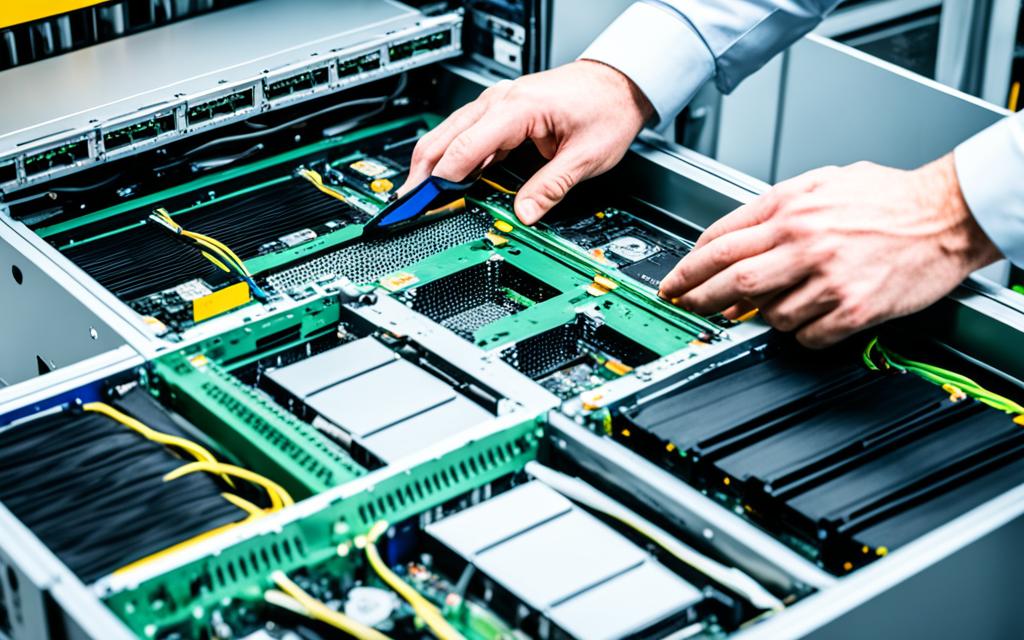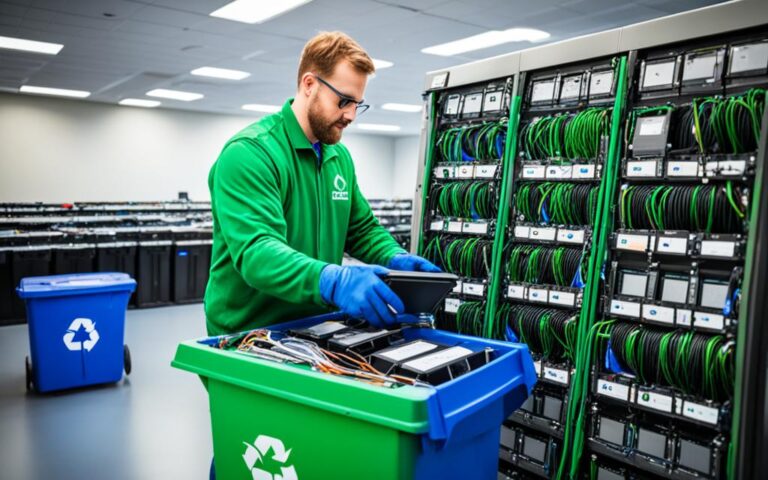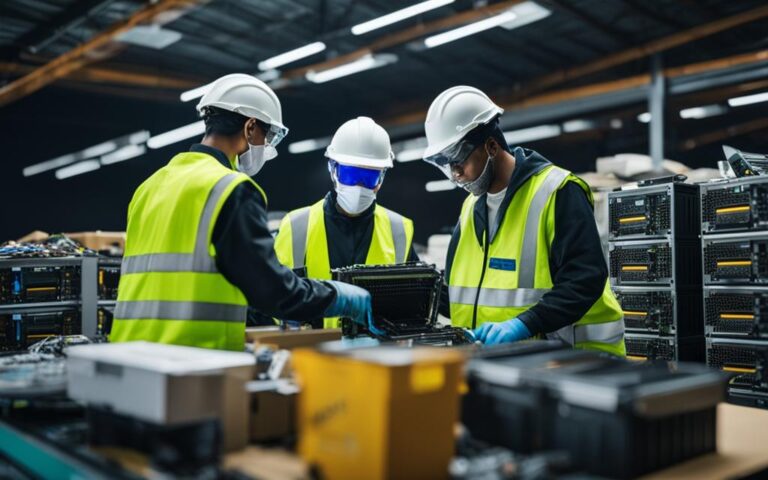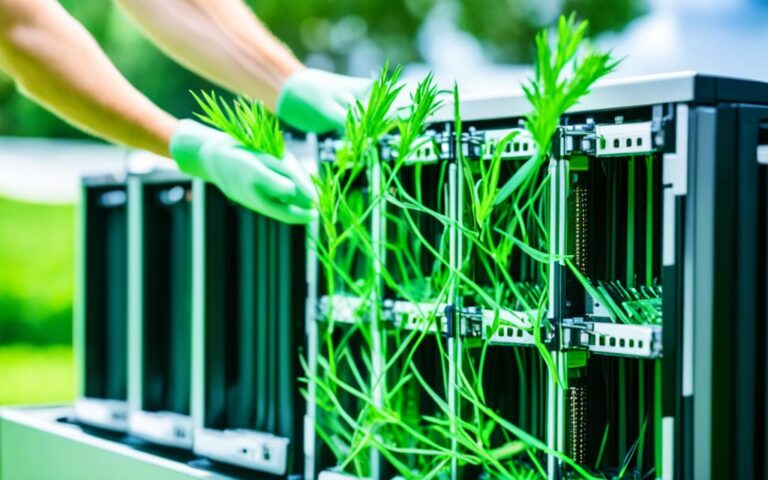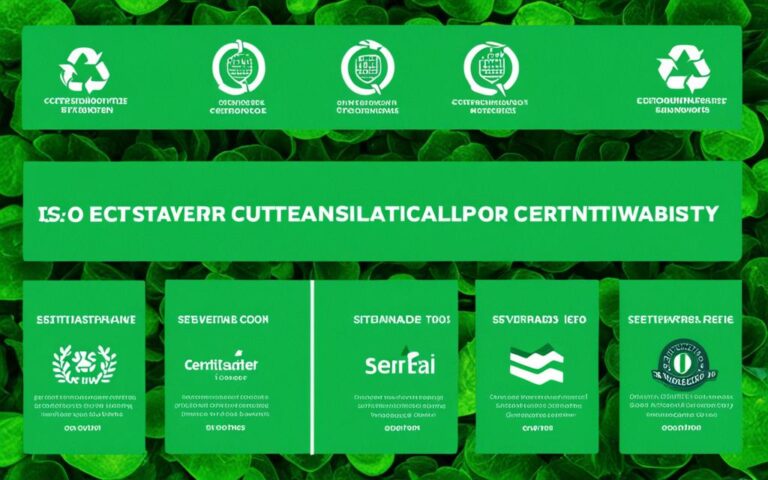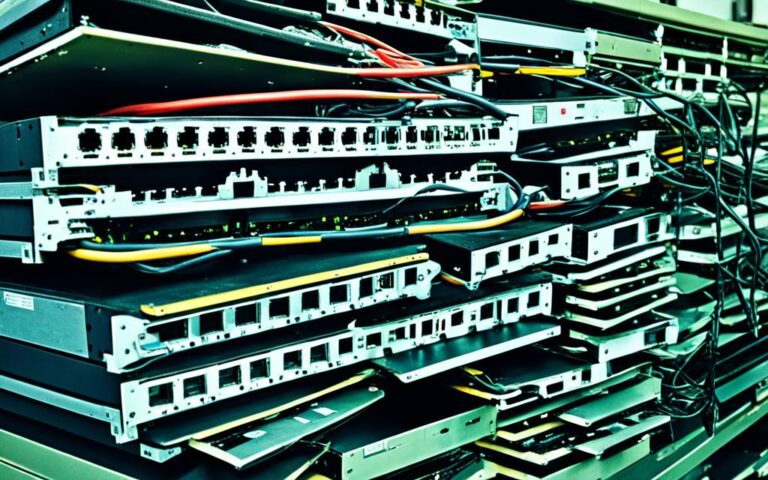The Benefits of Server Recycling for the Semiconductor Industry
The semiconductor industry plays a vital role in our technological advancements, powering devices that we rely on every day. However, this progress comes at a cost – electronic waste. To combat this issue and uphold environmental sustainability, server recycling has become increasingly essential.
By embracing server recycling, businesses in the semiconductor industry can contribute to a greener IT infrastructure while protecting the environment. Not only does recycling servers reduce electronic waste, but it also allows for the recovery of valuable materials that can be reused in new products.
When choosing a reputable server recycling company that follows proper procedures, businesses can achieve multiple advantages. They can rest assured knowing that their old servers will be disposed of responsibly, preventing toxic elements from contaminating the ecosystem. Moreover, server recycling promotes resource conservation, reduces energy consumption, and ensures the secure disposal of sensitive data.
Within this article, we will explore the importance of server recycling for the environment, the recycling process itself, the advantages it offers, and how to choose a reliable recycling company. Server recycling is not only a responsible choice but also a necessary step toward a more sustainable future for the semiconductor industry.
Why Server Recycling is Important for the Environment
Server recycling plays a crucial role in minimizing the environmental impact of the semiconductor industry. The disposal of servers can have significant consequences for the ecosystem and contribute to the growing problem of electronic waste. It is therefore essential to understand the importance of responsible server recycling and its positive effects on the environment.
Servers contain various toxic elements, such as cadmium, beryllium, and mercury. If not handled properly, these substances can contaminate the environment, posing a significant threat to human health and ecological balance. The improper disposal of servers results in these toxic elements leaching into soil and water sources, harming plant and animal life, and ultimately affecting entire ecosystems.
By recycling server components, we can prevent these harmful substances from entering the environment. The process of recycling server equipment involves the extraction and safe disposal of toxic materials, ensuring that they do not end up in landfills or pollute our natural resources. Instead, valuable components are recovered and reused, reducing the demand for new resources and lowering the overall environmental impact of the semiconductor industry.
Additionally, server recycling helps address the issue of electronic waste. The rapid advancement of technology has led to a constant stream of outdated and obsolete equipment. Without proper recycling practices, these discarded servers and other electronic devices contribute to the growing e-waste problem. By incorporating responsible server recycling into our practices, we can significantly reduce the amount of electronic waste being sent to landfills and promote a more sustainable approach to technology.
Server recycling is not just a matter of complying with regulations; it is a way to protect our environment, preserve natural resources, and pave the way for a greener future.
By choosing to recycle servers, businesses and individuals are taking an active role in preserving the environment and mitigating the negative impacts of the semiconductor industry. It is crucial to raise awareness about server recycling and encourage proper disposal practices to ensure a healthier planet for future generations.
Let us now explore the server recycling process in more detail, understanding how each step contributes to reducing environmental harm and promoting sustainability.
The table below illustrates the environmental impact of server recycling:
|——————|—————————–|————————|
| Environmental Impact | Benefits of Server Recycling |
|——————|—————————–|————————|
| Reduction of toxic waste | Prevents contamination of the environment |
|——————|—————————–|————————|
| Conservation of natural resources | Reduces the need for new resource extraction |
|——————|—————————–|————————|
| Decreased greenhouse gas emissions | Lower energy consumption due to reuse |
|——————|—————————–|————————|
| Promotion of sustainable practices | Minimizes electronic waste landfill deposition |
|——————|—————————–|————————|
As can be seen from the table above, server recycling offers numerous benefits, including the reduction of toxic waste, conservation of natural resources, decreased greenhouse gas emissions, and the promotion of sustainable practices. By actively participating in server recycling initiatives, we can contribute to a cleaner and more sustainable environment.
The Process of Server Recycling
Server recycling is a comprehensive process that involves waste removal, component separation and dismantling, data destruction, and material recycling. It is an essential step in ensuring the proper disposal and reuse of server components, contributing to a more sustainable approach to IT infrastructure.
Waste Removal and Collection
Server recycling begins with the collection of servers from various sources, including businesses, data centers, and individuals. The recycling company organizes the efficient removal of these servers, ensuring they are transported to the recycling facility in a safe and environmentally responsible manner.
Component Separation and Dismantling
At the recycling facility, the servers undergo meticulous component separation and dismantling. Skilled technicians carefully disassemble the servers, separating different components such as hard drives, memory modules, power supplies, and cooling systems. This systematic approach ensures that each component can be properly assessed and processed accordingly.
Data Destruction
Data destruction is a critical step in the server recycling process. As servers often store sensitive information, it is crucial to ensure that all data is securely destroyed to protect the privacy and confidentiality of individuals and businesses. Through specialized techniques and software, the recycling company ensures that all data is irreversibly wiped from the server components.
Material Recycling
Once the components have been separated and the data has been securely destroyed, the recycling company proceeds with the material recycling phase. Valuable materials such as precious metals, copper, aluminum, and plastics are extracted from the server components. These materials are then carefully processed and recycled to be used in the production of new electronic products, reducing the need for virgin materials and minimizing waste.
Server recycling plays a crucial role in preserving the environment and conserving valuable resources. By adhering to proper waste removal, component separation, data destruction, and material recycling practices, the semiconductor industry can significantly reduce electronic waste and contribute to a greener, more sustainable future.
Advantages of Server Recycling
Server recycling offers numerous benefits for businesses and the environment. By embracing responsible disposal practices, organizations can contribute to resource conservation, environmental protection, energy efficiency, and data security.
Resource Conservation
One of the key advantages of server recycling is the conservation of valuable resources. Servers contain various components such as metals, plastics, and rare earth elements, which can be extracted, processed, and reused in the production of new devices. By recycling servers, businesses reduce the demand for new raw materials, minimizing the need for resource extraction and promoting a circular economy.
Environmental Protection
Server recycling plays a vital role in protecting the environment. Discarded servers often end up in landfills, where their toxic components pose a threat to soil and water quality. Improper disposal can result in the release of hazardous substances like lead, mercury, and cadmium, which can contaminate ecosystems and harm human health. Recycling servers prevents these harmful materials from entering the environment, preserving natural resources and reducing pollution.
Energy Efficiency
Another significant advantage of server recycling is reducing energy consumption. The production of new servers requires substantial amounts of energy and resources. By reusing and refurbishing existing server components, businesses can significantly decrease their energy footprint. Reconditioning servers and extending their lifespan through recycling initiatives help conserve energy and mitigate the environmental impact associated with manufacturing new equipment.
Data Security
Data security is of utmost importance in today’s digital landscape. When servers reach the end of their lifecycle, they still contain sensitive information that must be securely destroyed. Server recycling companies ensure that all data stored on recycled servers is effectively wiped or destroyed, safeguarding businesses from data breaches and potential legal liabilities. Through comprehensive data destruction protocols, server recycling promotes secure and responsible handling of sensitive information.
| Advantages of Server Recycling | Description |
|---|---|
| Resource Conservation | Reusing valuable materials |
| Environmental Protection | Preventing pollution and reducing electronic waste |
| Energy Efficiency | Decreasing energy consumption and minimizing the environmental impact of manufacturing |
| Data Security | Securely destroying sensitive information to prevent data breaches |
Choosing a Reliable Server Recycling Company
When it comes to server recycling, selecting a reliable and experienced company is crucial. Not only does it ensure proper compliance with environmental standards, but it also guarantees the secure destruction of sensitive data. Here are some key factors to consider when choosing a server recycling company:
1. Experience: Look for a company with a proven track record in handling server components. Experience demonstrates their expertise in the field and their ability to handle recycling processes effectively.
2. Adherence to Environmental Standards: Choose a company that follows strict environmental standards and regulations. They should have proper certifications and demonstrate a commitment to sustainable practices.
3. Data Destruction Protocols: Data security is paramount when recycling servers. Ensure that the recycling company has robust data destruction protocols in place to protect sensitive information from falling into the wrong hands.
“Selecting a reliable and responsible server recycling company is not just about compliance, it’s about safeguarding your business and the environment.”
4. Customer Reviews: Read customer reviews or seek recommendations from other businesses to gauge the company’s reliability and professionalism. Positive feedback from satisfied customers is a good indicator of a trusted service provider.
By choosing a reliable server recycling company, you can have peace of mind knowing that your server components are handled responsibly, and your data is securely destroyed. Make an informed decision and contribute to a greener and more sustainable future for the semiconductor industry.
Key Considerations When Choosing a Server Recycling Company
| Consideration | Description |
|---|---|
| Experience | Look for a company with extensive experience in server recycling and handling server components. |
| Environmental Standards | Ensure the company adheres to strict environmental standards and regulations. |
| Data Destruction Protocols | Verify that the company has robust protocols in place to securely destroy sensitive data. |
| Customer Reviews | Read reviews and seek recommendations from other businesses to assess the company’s reliability. |
Conclusion
When considering the profitability of e-waste recycling, businesses must take into account various factors such as the volume of e-waste, material quality, and associated costs. While the financial considerations are important, it is crucial to recognize the environmental benefits that come with recycling electronic waste. By responsibly recycling server components in the semiconductor industry, businesses can contribute to a more sustainable and environmentally responsible future.
E-waste recycling offers numerous advantages, both for the planet and for businesses. Not only does it help conserve valuable resources by reusing materials, but it also plays a vital role in protecting the environment. Recycling servers prevents toxic substances like cadmium, beryllium, and mercury from contaminating the ecosystem, reducing the potential harm they may cause.
Furthermore, server recycling contributes to energy efficiency by reusing existing components rather than manufacturing new ones. This not only reduces energy consumption but also decreases the carbon footprint associated with the production process. Additionally, recycling servers ensures data security by securely destroying sensitive information, protecting businesses from potential breaches.
In conclusion, while the profitability of e-waste recycling may vary, it is essential to consider the long-term benefits it offers – both environmentally and financially. By embracing server recycling in the semiconductor industry, businesses can make a positive impact on the planet, reduce electronic waste, and pave the way for a greener future.
FAQ
Why is server recycling important for the semiconductor industry?
Server recycling is crucial for the semiconductor industry to ensure environmental sustainability and reduce electronic waste. By choosing a reputable recycling company that follows proper procedures, businesses can protect the environment, recover valuable materials, and contribute to a greener IT infrastructure.
What is the environmental impact of not recycling servers?
Servers contain toxic elements such as cadmium, beryllium, and mercury, which can contaminate the environment if not handled responsibly. Recycling server components prevents these harmful substances from entering the ecosystem and reduces electronic waste.
What is the process of server recycling?
The server recycling process involves waste removal and collection, component separation and dismantling, data destruction, and material recycling. Servers are collected from various sources and brought to the recycling facility. The recycling company separates the components, such as hard drives and memory modules, and extracts valuable materials. Data destruction ensures the secure disposal of sensitive information. The extracted materials are processed and recycled for use in new products.
What are the advantages of server recycling?
Server recycling offers numerous benefits for businesses and the environment. It helps conserve resources by reusing valuable materials, protects the environment by preventing pollution, reduces energy consumption by reusing existing components, and ensures data security by securely destroying sensitive information.
How do I choose a reliable server recycling company?
When choosing a server recycling company, it is important to consider their experience, expertise in handling server components, adherence to environmental standards, and data destruction protocols. Selecting a reliable and responsible company ensures proper compliance with regulations and protects sensitive data.
What factors affect the profitability of e-waste recycling?
The profitability of e-waste recycling depends on various factors, including the volume of e-waste, quality of the material, and associated costs. While recycling e-waste has environmental benefits, businesses must also consider the financial feasibility of the process. Overall, recycling server components in the semiconductor industry contributes to a more sustainable and environmentally responsible future.

